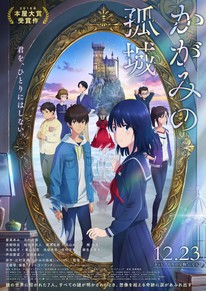Review
by Richard Eisenbeis,Lonely Castle in the Mirror
| Synopsis: |  |
||
One day, seven middle schoolers find themselves transported to a mysterious castle on the other side of their bedroom mirrors. Somewhere in the castle is a hidden room and the key to open it. The first of them to do so can have their wish granted. Yet, none of the children are too excited about the prize. Rather, the castle becomes their safe space where they can go to escape the problems of their everyday lives and, through their newfound friendships, begin to heal from their numerous, interpersonal traumas. |
|||
| Review: | |||
When it comes down to it, Lonely Castle in the Mirror is a commentary about one of Japan's most prevalent ongoing problems: school bullying. The viewpoint character of the film, Kokoro, has been bullied to the point that not only is she unable to go to school, but she also can't even explain to her parents what happened for fear of reliving her trauma. Of course, thanks to this lack of communication, her parents can't understand or give her the support she needs beyond letting her stay home alone for literal months on end. Outside the castle, there is only one person trying to understand and help Kokoro: Mrs. Kitajima, a teacher at a special school for bullied kids. She goes above and beyond, checking in on Kokoro and talking with her parents and other teachers—not trying to “fix” Kokoro but letting her know that she has someone she can rely on no matter the time or place. Of course, while the film doesn't advocate for people like Mrs. Kitajima being some magical solution to the bullying problem, it is quick to show that her empathy at least lets Kokoro and other children have a lifeline when they need it most. The other way that Kokoro can start healing is through the other middle schoolers she meets in the castle. Each has a similar problem—like the bullying she faces or parental abuse. While they each put up a front of sorts, being around those with similar experiences means that everyone is a bit more empathetic and kind—unwilling to become the monster that terrorized them. And while they make mistakes and slip up from time to time—some people don't get along, after all—this air of companionship eventually allows many of the characters to open up about what they face and work together on moving forward. This exploration of bullying and how to combat it (along with other domestic problems) is all tied together through a fantastical mystery. What is the castle? Where did it come from? Why was each of them chosen? How are they connected? Who is the girl in the wolf mask who serves as their gamemaster/caretaker? Can the secret room in the castle really grant any wish? And is it true that if they break the castle's rules, a wolf will come and eat them? Moreover, thanks to the ticking clock, the film always has a looming sense of urgency. Our seven heroes have just a year to get a wish granted (if they even choose to go that route) and heal enough to survive in a world without the safety and companionship found in the castle. Because of this, even though the film's primary focus is the trauma and subsequent personal healing of our heroes, it never drags. Instead, it feels like they'll never have enough time to finish everything they need before time runs out. As for the visuals, the film is by no means a powerhouse regarding the animation, but the backgrounds genuinely stand out. Through them alone, we can quickly grasp the castle's layout and know precisely where each of our characters are in every scene. This is especially important when things get more hectic towards the film's end. The scenes that depict each of the seven children's traumatic moments stand out, and the dread and horror of these situations come across perfectly—even if you have had no similar events in your life. On the aural side of things, the music does its job but is largely forgettable. However, the ending theme, “Merry Go Round” by Yuuri, which plays during the film's credits and emotional epilogue, hits hard—and might make you shed a tear or two even listening to it after the movie ends. Overall, Lonely Castle in the Mirror is a film with an important message about an ongoing problem with no easy solution. In the most general sense, it shows how adults can help suffering children by giving them a lifeline when they need help most and making sure they know it exists. At the same time, it shows how these traumatized kids can help each other by giving each other the empathy they wish they had received and regain the confidence to succeed in the (all-too-often unfair) world we all live in. |
| Grade: | |||
|
Overall : B-
Story : B
Animation : C+
Art : B
Music : C+
+ Social commentary on Japan's ongoing school bullying problem with potential solutions. A cast of relatable characters and a multi-layered mystery to keep things interesting. |
|||
| discuss this in the forum (2 posts) | | |||
| Production Info: | ||
|
Full encyclopedia details about |
||